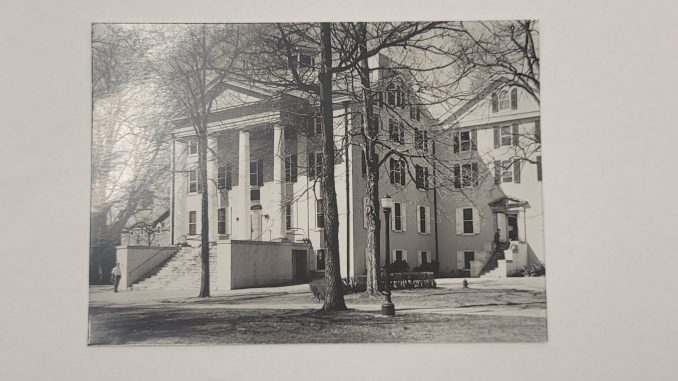
Details
Article by Sidney Belleroche <sibelleroche@ursinus.edu>
In the Myrin Library, unnoticed by the diligent students working on their various assignments, there is a small, unassuming room tucked away on the second floor. This room is the definition of a hidden gem and one of the most important places in all of Ursinus College: the Archives.
The formal name of the room is the Ursinusiana, but it is most often referred to as simply the Archives. As the name suggests, the Ursinus Archives hold records, mementos, and artifacts collected throughout Ursinus’s 154-year history. Some of these include editions of past student publications like the Lantern, Ruby, and Grizzly, as well as sporting records.
Maintaining the records is a crucial task and one that fittingly falls onto a long-serving staff member at Ursinus, Carolyn Weigel. Weigel, who recently celebrated her thirtieth year here at Ursinus, was not originally the archivist. “I started out cataloging here,” she laughed. She switched to working in the Archives in 1995 after two years as a cataloger, took additional archival courses through Temple, and became Ursinus’s official archivist in 1999. Weigel, an Illinois native and Southern Illinois University alum, has made the Collegeville area her home over the past thirty years. When asked why she has remained for so long, Weigel stated, “I love the campus, students, and faculty. Additionally, I live close to the area. Ten minutes to arrive in the morning and ten in the evening.”
The daily happenings of the Archives are varied. “Some days are busier than others,” Weigel shared. According to Weigel, her day typically consists of responding to emails and answering inquiries about specific topics in the Archives. On her busier days, she hosts classes, namely history, and lays out documents on the central table for examination. These group reviews of the Archives are one of Weigel’s favorite parts of her job. “I get enjoyment when classes join,” she said. “Typically, the classes read aloud and make insightful comments. Despite being here for thirty years, I still learn a lot because it is impossible to read every single document here.”
The work of an archivist is not easy. As Weigel mentioned, many documents are stored in the Archives, and some inquiries take longer than others. It sometimes takes Weigel a week or two to find a desired answer. And, as with all history, some answers may not be found. “What is here is here,” Weigel commented. “The Archives is a physical presence. If it is not in the Archives, then it is often forgotten.” Andy Prock, the Associate Director of Preservation, Digitization & Discovery Services, and others have worked to digitize as many documents as possible, but the process is ongoing.
Nevertheless, the Ursinus Archives contain interesting relics and tidbits about Ursinus’s history. In the office, a large grandfather clock stems from the Shaw Bernard collection in the 1920s. It rings every fifteen minutes and plays a lovely symphony at the top of each hour. The low exhibit cases, one on the first floor and the other on the second, are also from that collection. While in good condition, the clock is slightly damaged from another event in Ursinus lore: the Myrin Library flood of 2003.
“On December 26th, a pipe burst,” Weigel recalled. “The burst size was no larger than a quarter, but nobody noticed for sixteen hours! It took until around spring 2005 for the library to fully recover.” She then pulled out a Grizzly article from that time, covering the flood on the first page.
Another interesting bit was the Freeland Hall bell. “Freeland Hall used to stand where the [Myrin] library is now,” Weigel explained. “It used to be a seminary before that as well. When the building deteriorated in the 1960s, Freeland Hall was razed, and the [Myrin] library is here now.” The old Freeland Hall bell now sits on the library’s second floor, a remnant of a bygone era.
In the Ursinusiana, Carolyn Weigel has seen Ursinus change through the years. “The physical buildings have changed; the students have changed,” she reflects, “but the spirit has stayed the same—that sense of belonging and pride. Ursinus personnel have gone on to make marks on the world. Whether it be John Mauchly [co-inventor of the first purely electronic, digital computer] teaching physics here or J.D. Salinger [author of The Catcher in the Rye] spending a semester here, there have been a lot of interesting people at Ursinus.”
Weigel had two messages when asked what she would tell the student body. “It is fun to come and touch the items [at the Archives]. You are unaware of how special it is until you do it. I want to show you what’s here and answer questions about the college. Additionally, cherish your days here at Ursinus.”
